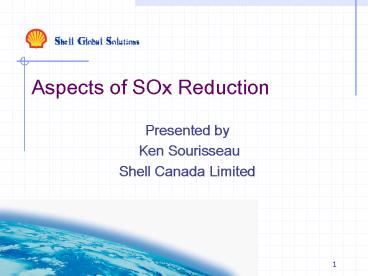Aspects of SOx Reduction - PowerPoint PPT Presentation
1 / 23
Title:
Aspects of SOx Reduction
Description:
Determined by temperature and residual amine loading. Tail gas may contain 250 ppmv H2S ... Integrate SCOT amine with primary treating or enrichment. One ... – PowerPoint PPT presentation
Number of Views:176
Avg rating:3.0/5.0
Title: Aspects of SOx Reduction
1
Aspects of SOx Reduction
- Presented by
- Ken Sourisseau
- Shell Canada Limited
2
Sulfur Pathways
- Fossil fuels contain sulfur
- Natural gas H2S, COS, mercaptans
- Oil, chemical bound in heavy hydrocarbons
- Sulfur recovered as H2S from processing
- H2S converted to elemental sulfur and recovered
- Unrecovered sulfur oxidized before release to
atmosphere - Sulfur released as SOx (Majority SO2, unusual
operation SO3)
3
Sulfur Recovery Options
- Very Small (lt250 kg/d) Use Adsorbents
- 99.9 recovery
- Small (1/4 20 t/d)
- 99.9 recovery
- Biological Shell Paques,
- Liquid Redox LoCat, CrystaSulf, Sulferox,
- Medium to Large
- 96 - 99.8 recovery
- Modified Claus (Thermal Catalytic)
- Claus Extensions
- Claus plus Tail Gas Treating
4
Sulfur Recovery Efficiency
- Modified Claus (92 to 97)
- Claus Extensions (98 to 99.3/-)
- SCOT Tail Gas Treating (99.8)
5
Modified Claus (95 Recovery)
- Catalytic stages operate at 240 oC to 345 oC
- Third stage increases recovery to 97
6
Modified Claus Recovery Limits
- Equilibrium in last stage means some reactants
not converted - Non conversion of COS and CS2
- Sulfur vapour from last condenser
- Sulphur droplet mist from last condenser
7
Claus Extension (99 Recovery)
- Direct catalytic partial oxidation SUPERCLAUS
- Sub dewpoint CBA, Sulfreen, MCRC
- New units less common
8
Claus Extension Recovery Limits
- SO2 in tail gas
- Minimized by selecting operating conditions
- Non conversion of COS and CS2
- Sulfur vapour from last condenser
- Sulphur droplet mist from last condenser
9
SCOT (99.8 Recovery)
- Shell Claus Offgas Treatment (SCOT)
10
SCOT (99.8 Recovery)
11
SCOT Recovery Limits
- H2S equilibrium at the top of the absorption
column - Determined by temperature and residual amine
loading - Tail gas may contain 250 ppmv H2S
12
Costs of Increased Efficiency
- Significantly more equipment than Claus
extensions - Increased capital
- Increased ongoing operating and maintenance costs
- Energy requirements
- Fuel for reduction burner (CO2 emissions)
- Steam for regeneration
- May be available as surplus
- Generation will result in energy consumption and
CO2 emissions
13
Sulfur Recovery Efficiency Improvement Costs
- Relative capital cost
- Claus (3 stage) 100
- Claus Extension (2 Plus 1) 120
- Claus SCOT (2 plus) 130 - 170
- Costs are relative and indicative. Actual cost
differences require detailed engineering
14
SCOT Improvements
- Low temperature SCOT
- Improved catalyst operates at lower temperature
- Reduced fuel requirements
- Reduced CO2 emissions
- Steam reheater
- Utilize available steam for reheat
- Simplified system reduces capital and operating
costs - Reduced CO2 emissions if surplus steam is
available
15
SCOT Integration Opportunities
- Integrate SCOT amine with primary treating or
enrichment - One regenerator with higher flow rates
- Reduced capital cost
- Reduced steam consumption
- Cascade SCOT amine to primary treater
- Amine from SCOT reused in high pressure absorber
- One regenerator with lower flow rates
- Reduced capital cost
- Further reduction steam consumption
16
SCOT Unit Upsides
- Cooling
- Winter conditions improve cooling and provide
seasonal improvements in recovery - Regeneration
- Deeper regeneration has the potential to also
improve overall recovery - Increased energy consumption
- Increased capital cost
17
Sulfur Capacity/Efficiency
SO2 emission 2 x sulfur emission
18
Recovery Efficiency vs Technology
19
Claus Reaction Furnace
20
Claus Converter
21
SCOTReactor
22
SCOT Unit Vessels
23
Thank You
- Questions?































